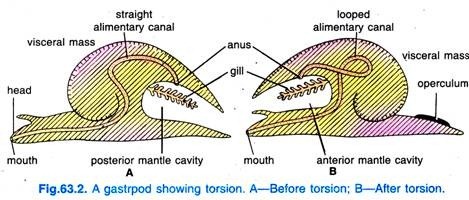The below mentioned article provides a brief account of torsion and detorsion in Gastropoda.
Torsion in Gastropoda:
Mollusca are typically bilaterally symmetrical animals but this symmetry is lost in Gastropoda due to two processes called coiling and torsion. There is a tendency for digestion and resorption to be confined to a dorsal digestive gland or liver, the liver undergoes growth to form a projection which grows so much that it falls over to one side causing a coiling of the alimentary canal into a visceral hump.
The visceral hump grows faster on one side than on the other, so that it is twisted into a compact spiral which is directed posteriorly to keep the balance of the animal, the shell is also coiled. With this spiral coiling one may confuse another process called torsion of the visceral mass, but this coiling evolved before torsion.
The visceral hump behind the head includes the visceral mass, mantle, mantle cavity, and foot; it rotates in a counter-clockwise direction through an angle of 180° on the rest of the body by contraction of an asymmetric retractor muscle which arises from the right side of the larval shell, passes over the body and gets inserted to the left side of the head.
This rotation is known as torsion which is distinct from coiling and is a much more drastic change, it occurs after coiling of the visceral hump.
In torsion only a narrow part of the body and the organs which pass through it are twisted, it is that small part which lies between the visceral hump and the rest of the body. Torsion changes the orientation of the mantle cavity and its organs, and the organs of the left side tend to be reduced or even lost.
Before torsion the mantle cavity opens posteriorly, ctenidia point backwards, the auricles are behind the ventricle, the nervous system is bilaterally symmetrical, and the mouth and the anus are at opposite ends.
After torsion the mantle cavity opens in front just behind the head, ctenidia come to lie in front and point anteriorly, the ctenidium of the right side comes to lie on the left and that of the left side on the right, the auricles become anterior to the ventricle, the auricle of the right side comes to lie on the left and vice versa, the nervous system is twisted into a figure of 8 by the crossing of the two long nerve connectives running to the viscera, and the digestive system becomes U-shaped so that the anus comes to lie in front near the mouth.
The entire process of torsion generally takes only a few minutes.
In primitive Gastropoda there are two ctenidia, two auricles and two kidneys, but in more specialised forms the real left but topographically right ctenidium, right auricle and the right kidney fail to form; this absence of organs of the right side is a consequence of torsion.
The number of auricles is directly related with the number of ctenidia present, and the loss of one gill leaves only one auricle.
It is not clear whether torsion is an advantage or not to the animal, or if it has any evolutionary significance, but it takes place during the embryological development of gastropods, the larva is a first bilaterally symmetrical, then quite suddenly it undergoes torsion. In some forms after the coiling of the visceral hump, torsion occurs by rotation only through 90°, so that the ctenidia and anus point laterally.
Detorsion in Gastropoda:
In some forms the changes brought about by torsion are reversed to a certain extent, while in others, e.g., Aplysia a complete reversal of torsion takes place which is known as detorsion, this occurs when the shell is lost or much reduced, the ctenidia liberated from their enclosing case point posteriorly again, their anterior position being of no advantage, and the visceral hump gets completely untwisted.
In Cephalopoda the body has become greatly elongated along the dorso-ventral axis, and as a result of change in the method of locomotion this axis has become the functional anteroposterior axis. A ring of tentacles lies at the anterior end of the body and the visceral hump is posterior, the original mantle cavity has become ventral.
